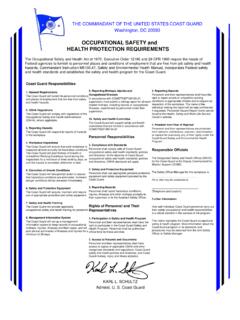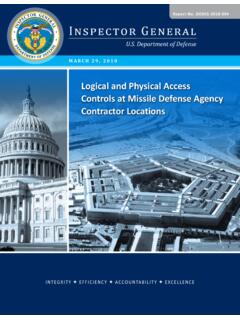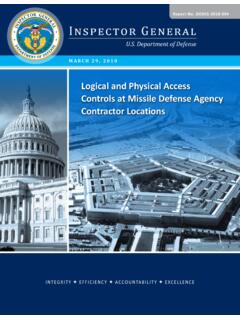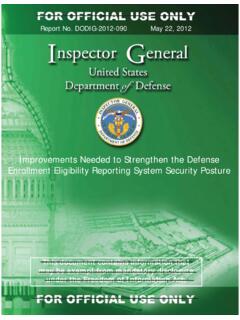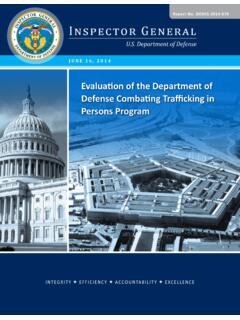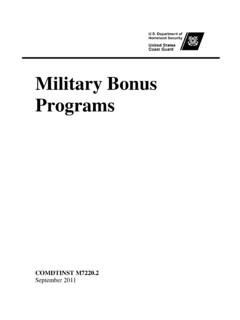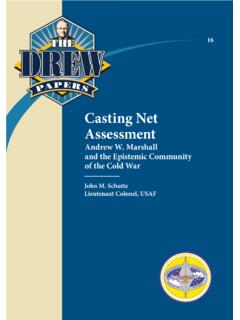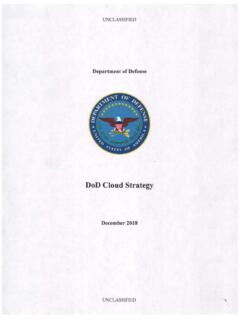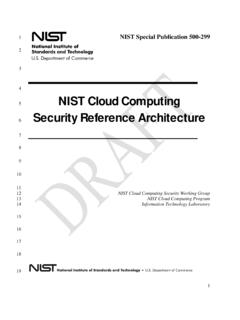Transcription of Mitigating Cloud Vulnerabilities - U.S. Department of Defense
1 U/OO/106445-20 PP-20-0025 22 JANUARY 2020 National Security Agency | Cybersecurity Information Mitigating Cloud Vulnerabilities While careful Cloud adoption can enhance an organization s security posture, Cloud services can introduce risks that organizations should understand and address both during the procurement process and while operating in the Cloud . Fully evaluating security implications when shifting resources to the Cloud will help ensure continued resource availability and reduce risk of sensitive information exposures. To implement effective mitigations, organizations should consider cyber risks to Cloud resources, just as they would in an on-premises environment. This document divides Cloud Vulnerabilities into four classes (misconfiguration, poor access control, shared tenancy Vulnerabilities , and supply chain Vulnerabilities ) that encompass the vast majority of known Vulnerabilities .
2 Cloud customers have a critical role in Mitigating misconfiguration and poor access control, but can also take actions to protect Cloud resources from the exploitation of shared tenancy and supply chain Vulnerabilities . Descriptions of each vulnerability class along with the most effective mitigations are provided to help organizations lock down their Cloud resources. By taking a risk-based approach to Cloud adoption, organizations can securely benefit from the Cloud s extensive capabilities. This guidance is intended for use by both organizational leadership and technical staff. Organizational leadership can refer to the Cloud Components section, Cloud Threat Actors section, and the Cloud Vulnerabilities and Mitigations overview to gain perspective on Cloud security principles. Technical and security professionals should find the document helpful for addressing Cloud security considerations during and after Cloud service procurement.
3 Cloud Components Cloud architectures are not standardized and each Cloud Service Provider (CSP) implements foundational Cloud services differently. Understanding a CSP s Cloud implementation should be part of a customer s risk decision during Cloud service procurement. Four Cloud architectural services are common to most clouds: Identity and Access Management (IdAM): IdAM refers to controls in place for customers to protect access to their resources as well as controls that the CSP uses to protect access to back-end Cloud resources. Secure customer and Cloud back-end IdAM, both enforcement and auditing, is critical to protecting Cloud customer resources. Compute: Clouds generally rely on virtualization and containerization to manage and isolate customer computation workloads. Serverless computing , the dynamic allocation of Cloud compute resources to run customer code, is built upon either virtualization or containerization, depending on the Cloud service.
4 Virtualization is a Cloud backbone technology, not only for customer workloads, but also for the Cloud architecture itself. Virtualization is an enabling technology that provides isolation in the Cloud for both storage and networking. Virtualization typically implements and secures internal Cloud nodes. Containerization is a more lightweight technology that is commonly used in clouds to manage and isolate customer workloads. Containerization is less secure of an isolation technology than virtualization because of its shared kernel characteristics, but CSPs offer technologies that help address containerization security drawbacks. Networking: Isolation of customer networks is a critical security function of the Cloud . In addition, Cloud networking must implement controls throughout the Cloud architecture to protect customer Cloud resources from insider threat.
5 Software Defined Networking is commonly used in the Cloud to both logically separate customer networks and implement backbone networking for the Cloud . Storage (Objects, Blocks, and Database Records): Customer data is logically separated from other customer data on Cloud nodes. Security mechanisms must exist to ensure that customer data is not leaked to other customers and that customer data is protected from insider threat. Cloud Encryption and Key Management While not a base component of Cloud architectures, encryption and key management (KM) form a critical aspect of protecting information in the Cloud . While the CSP uses encryption (among other controls) to protect some aspects of customer data from other customers and CSP employees, Cloud customers should understand the options that they have for further protecting their data.
6 Understanding data sensitivity requirements is crucial for building a Cloud encryption and key management strategy. U/OO/106445-20 PP-20-0025 22 JANUARY 2020 2 Cybersecurity Information | Mitigating Cloud Vulnerabilities Customers can take advantage of CSP-provided encryption and KM services. Cloud -based KM services are designed to integrate with other Cloud services, reducing the amount of customer development needed to protect and process data in the Cloud . Cloud -based KM services are able to provide audit information to customers about key creation, destruction and usage. In addition to software-based solutions, many CSPs offer a Hardware Security Module (HSM) service for protecting customer keys in the Cloud . Customers can also choose to provide the Cloud with externally generated keys for use in encryption (Bring Your Own Key).
7 Some CSP-provided encryption and KM solutions are accredited to protect sensitive but unclassified DoD information. Customers can also perform encryption and KM outside of the Cloud , using customer or third-party tools. Keeping encryption and KM outside of the Cloud ensures that customer data is never exposed to Cloud administrators. Additionally, pre-encrypted data is protected from exposure to other customers if there is a failure in the CSP's multi-tenancy controls. The consequences to this solution are that: (1) customers or third-party vendors must build encryption into the application or data management layers of their systems and become responsible for KM, which requires significant expertise and effort; and (2) the solution does not integrate well with other CSP services, requiring the customer to integrate their external applications or services with the Cloud and limiting the adoption of visualization, AI, and other data-layer services.
8 For example, pre-encrypted data generally cannot be searched or operated on in the Cloud . Sharing Cloud Security Responsibilities CSPs and Cloud customers share unique and overlapping responsibilities to ensure the security of services and sensitive data stored in public clouds. CSPs are responsible for securing the Cloud infrastructure, as well as implementing logical controls to separate customer data. Organizational administrators are usually responsible for configuring application-level security ( , access controls for authorization to data). Many CSPs provide Cloud security configuration tools and monitoring systems, but Cloud customers are responsible for configuring the service according to organizational security requirements. Shared responsibility affects routine operations, such as patch management, and exceptional events, such as security incident response.
9 Specific responsibilities vary by CSP, by Cloud service type ( , Infrastructure as a Service [IaaS] vs. Platform as a Service [PaaS]), and by specific product offering ( , managed vs. unmanaged virtual machines). Figure 1 shows a common mapping of these responsibilities. Figure 1: Cloud Shared Responsibility Model Shared responsibility considerations include: Threat Detection: While CSPs are generally responsible for detecting threats to the underlying Cloud platform, customers bear the responsibility of detecting threats to their own Cloud resources. CSPs and third parties may offer Cloud -based tools that can assist customers in threat detection. U/OO/106445-20 PP-20-0025 22 JANUARY 2020 3 Cybersecurity Information | Mitigating Cloud Vulnerabilities Incident Response: CSPs are uniquely positioned to respond to incidents internal to the Cloud infrastructure and bear responsibility for doing so.
10 Incidents internal to customer Cloud environments are generally the customer s responsibility, but CSPs may provide support to incident response teams. Patching/Updating: CSPs are responsible for ensuring that their Cloud offerings are secure and rapidly patch software within their purview but usually do not patch software managed by the customer ( , operating systems in IaaS offerings). Because of this, customers should vigilantly deploy patches to mitigate software Vulnerabilities in the Cloud . In some cases CSPs offer managed solutions in which they perform operating system patching as well. Cloud Threat Actors Threat actors may target the same types of weaknesses in both Cloud and traditional system architectures. This section focuses on Cloud -specific activities, but administrators should be aware that traditional tactics still apply.
